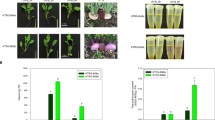Abstract
The tocopherols are amphipathic antioxidant synthesized by photosynthetic organisms, which forms the essential component in the human diet. To increase the α-tocopherol content in tobacco, two approaches have been attempted in this study: (1) transgenic approach, by constitutive overexpression of the genes encoding Arabidopsis homogentisate phytyltransferase (HPT) and tocopherol cyclase (TC) through Agrobacterium-mediated genetic transformation; (2) non-transgenic approach, by supplementation of intermediates/precursors of vitamin E biosynthesis like tyrosine, p-hydroxyphenyl pyruvic acid, homogentisic acid (HGA) and phytol in different concentrations and combinations using cell suspension culture system. Molecular analyses by PCR, RT-PCR and Southern hybridization were carried out to confirm the HPT and TC expressing transgenic tobacco lines. The α-tocopherol content in transgenic plants expressing HPT and TC increase by 5.5 and 4.1, respectively, over the wild type. These results indicate that, HPT and TC activities are important in tobacco plants for enhancing the vitamin E content. In the second approach, the supplementation of precursor in cell suspension cultures, i.e., combination of 150 μM HGA + 100 μM phytol, showed the maximum enhancement of α-tocopherol, i.e., 36-fold. These findings clearly imply that enhancement of α-tocopherol levels in tobacco system is possible, if we could modulate the vitamin E metabolic pathway. This is a very useful finding for the large-scale production of natural Vitamin E. Among the two systems tested, cell suspension culture-based system is ideal over the transgenic technology due to its efficiency and no biosafety concerns.







Similar content being viewed by others
References
Brigelius-Flohe R, Traber MG (1999) Vitamin E: function and metabolism. FASEB J 13:1145–1155
Cahoon EB, Hall SE, Ripp KG, Ganzke TS, Hitz WD, Coughlan SJ (2003) Metabolic redesign of vitamin E biosynthesis in plants for tocotrienol production and increased antioxidant content. Nat Biotechnol 21:1082–1087
Caretto S, Bray Speth E, Fachechi C, Gala R, Zacheo G, Giovinazzo G (2004) Enhancement of vitamin E production in sunflower cell cultures. Plant Cell Rep 23:174–179
Collakova E, DellaPenna D (2001) Isolation and functional analysis of homogentisate phytyltransferase from Synechocystis sp. PCC 6803 and Arabidopsis. Plant Physiol 127:1113–1124
Collakova E, DellaPenna D (2003a) Homogentisate phytyltransferase activity is limiting for tocopherol biosynthesis in Arabidopsis. Plant Physiol 131:632–642
Collakova E, DellaPenna D (2003b) The role of homogentisate phytyltransferase and other tocopherol pathway enzymes in the regulation of tocopherol synthesis during abiotic stress. Plant Physiol 133:930–940
Gala R, Mita G, Caretto S (2005) Improving α-tocopherol production in plant cell cultures. J Plant Physiol 162:782–784
Herrman KM, Weaver LM (1999) The shikimate pathway. Annu Rev Plant Physiol Plant Mol Biol 50:473–503
Hofgen R, Willmitzer L (1988) Storage of competent cells for Agrobacterium transformation. Nucleic Acids Res 16:9877
Karunanandaa B, Qi Q, Hao M, Baszis S, Jensen P, Wong Y-HH, Jiang J, Venkatramesh M, Gruys KJ, Moshiri F, Post-Beittenmiller D, Weiss JD, Valentin HE (2005) Metabolically engineered oilseed crops with enhanced seed tocopherol. Metab Eng 7:384–400
Norris SR, Barette TR, DellaPenna D (1995) Genetic dissection of carotenoid synthesis in Arabidopsis defines plastoquinone as an essential component of phytoene desaturation. Plant Cell 7:2139–2149
Norris SR, Shen X, DellaPenna D (1998) Complementation of the Arabidopsis pdsI mutation with the gene encoding p-hydroxyphenyl dioxygenase. Plant Physiol 117:1317–1323
Qi Q, Karunanandaa B, Hao M, Baszis S, Wong Y, Jiang J, Jensen P, Warren A, Moshiri F, Gruys KJ, Venkatramesh M, Valentin HE (2003) Metabolic engineering of tocopherol biosynthesis for increased tocopherol content in Arabidopsis and Synechocystis sp. PCC6803. Plant Physiol (Supplement) Abstract no 1074
Rao RS, Ravishankar GA (2002) Plant cell cultures: chemical factories of secondary metabolites. Biotechnol Adv 20:101–153
Rippert P, Scimemi C, Dubald M, Matringe M (2004) Engineering plant shikimate pathway for production of tocotrienol and improving herbicide resistance. Plant Physiol 134:92–100
Rise M, Cojocaru M, Gottlieb HE, Goldschmidt EE (1989) Accumulation of α-tocopherol in senescing organs as related to chlorophyll degradation. Plant Physiol 89:1028–1030
Rohmer M (2003) Mevalonate-independent methylerythritol phosphate pathway for isoprenoid biosynthesis: elucidation and distribution. Pure Appl Chem 75:375–388
Savidge B, Weiss JD, Wong Y-HH, Lassner MW, Mitsky TA, Shewmaker CK, Post-Beittenmiller D, Valentin HE (2002) Isolation and characterization of tocopherol prenyltransferase genes from Synechocystis PCC 6803 and Arabidopsis. Plant Physiol 129:321–333
Schledz M, Seidler A, Beyer P, Neuhaus G (2001) A novel phytyltransferase from Synechocystis sp. PCC 6803 involved in tocopherol biosynthesis. FEBS Lett 499:15–20
Tsegaye Y, Shintani D, DellaPenna D (2002) Overexpression of the enzyme p hydroxyphenolpyruvate dioxygenase in Arabidopsis and its relation to tocopherol biosynthesis. Plant Physiol Biochem 40:913–920
Wiktorowska E, Długosz M, Janiszowska W (2010) Significant enhancement of oleanolic acid accumulation by biotic elicitors in cell suspension cultures of Calendula officinalis L. Enzyme Microb Technol 46:14–20
Xu J, Ge X, Dolan MC (2011) Towards high yield production of pharmaceutical proteins with plant cell suspension cultures. Biotechnol Adv 29:278–299
Acknowledgments
The authors are very thankful to Defence Research and Developmental Organization—Centre for Life Sciences, Bharathiar University, for financial assistance and support.
Author information
Authors and Affiliations
Corresponding author
Additional information
Communicated by Z. Miszalski.
Rights and permissions
About this article
Cite this article
Harish, M.C., Dachinamoorthy, P., Balamurugan, S. et al. Enhancement of α-tocopherol content through transgenic and cell suspension culture systems in tobacco. Acta Physiol Plant 35, 1121–1130 (2013). https://doi.org/10.1007/s11738-012-1149-x
Received:
Revised:
Accepted:
Published:
Issue Date:
DOI: https://doi.org/10.1007/s11738-012-1149-x




